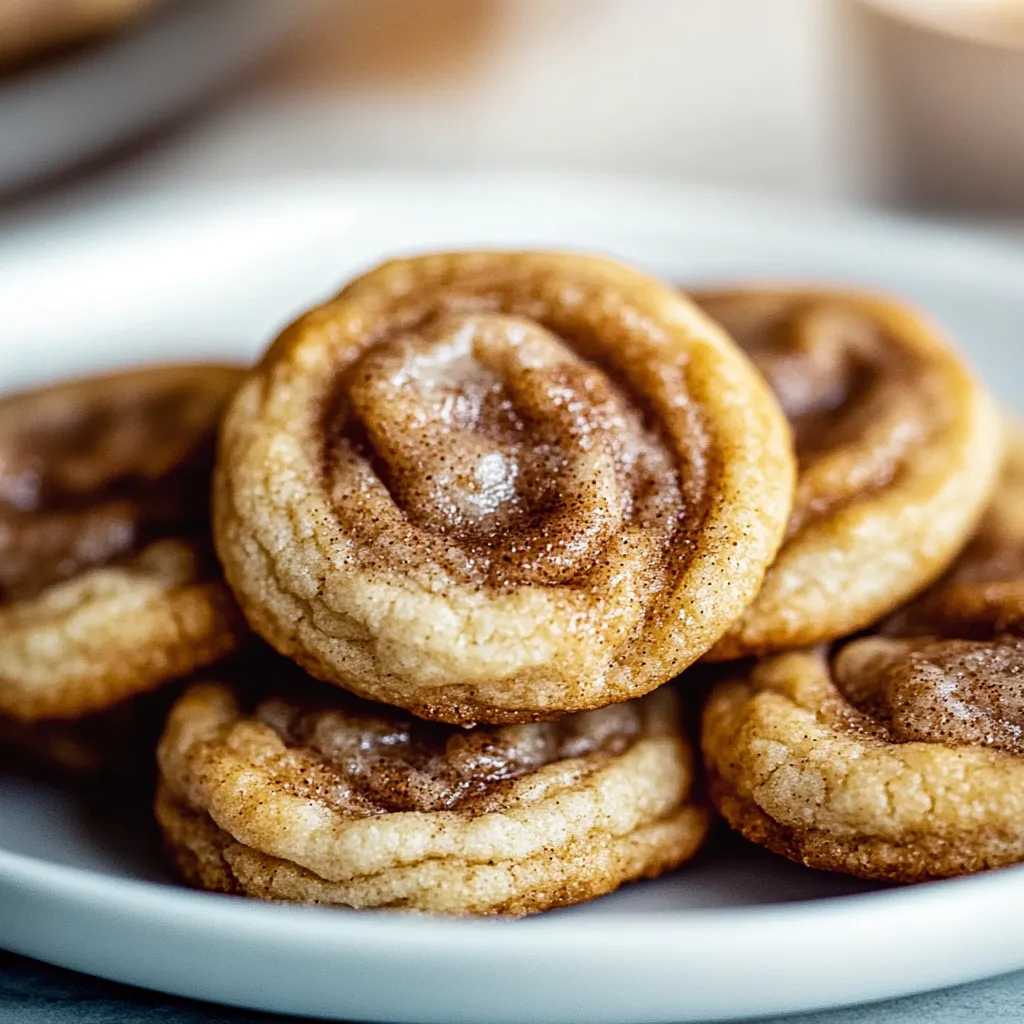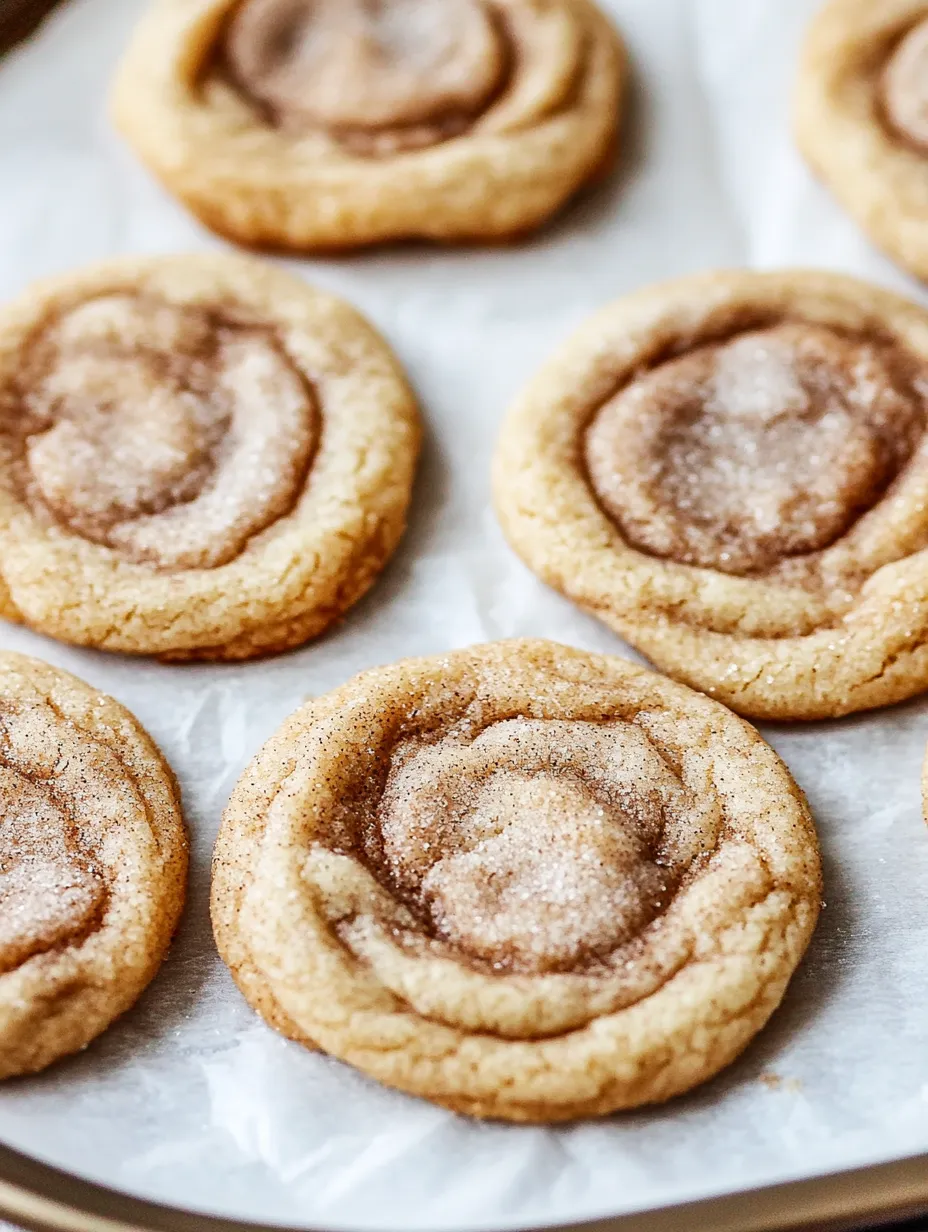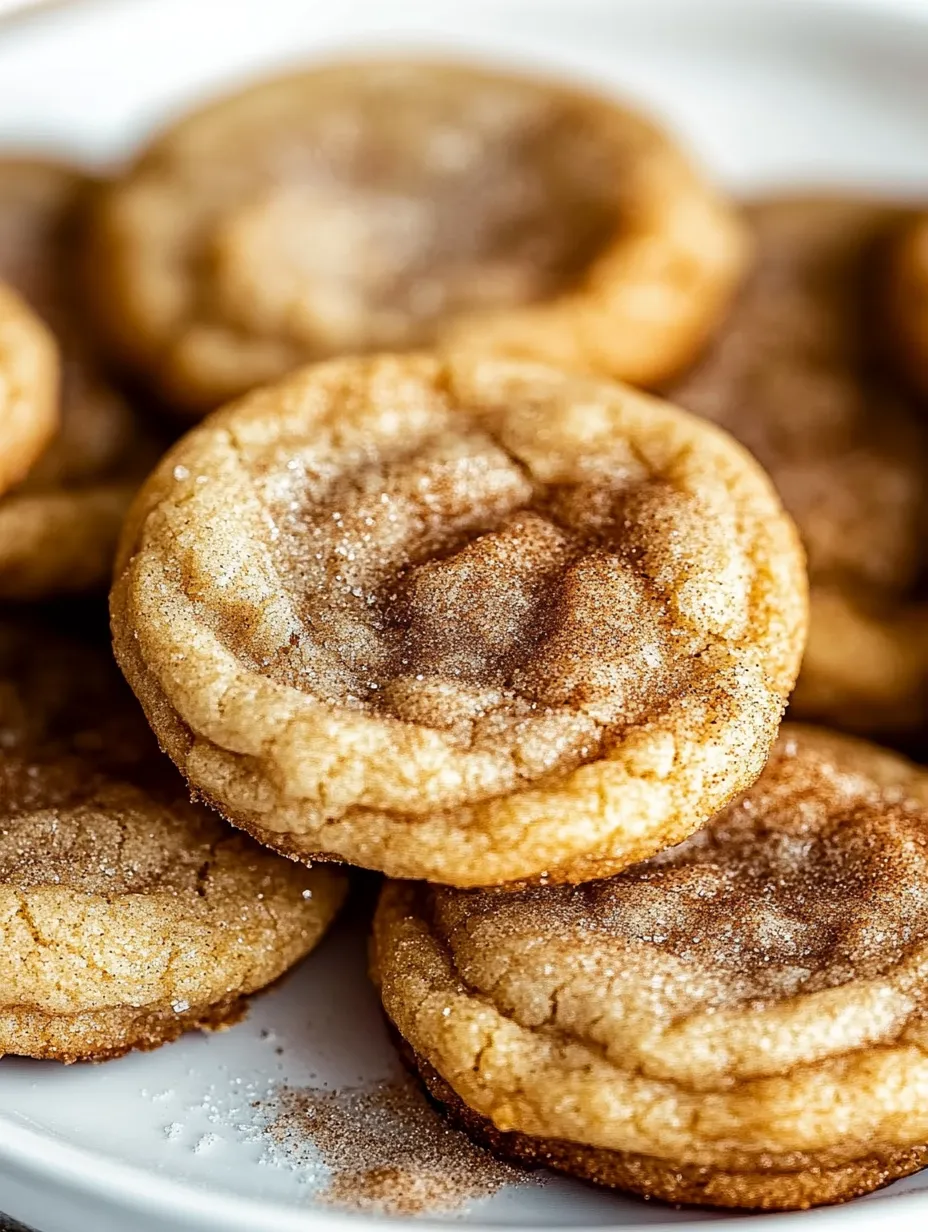 Pin it
Pin it
Cinnamon roll cookies capture all the warm, spicy comfort of traditional cinnamon rolls in a convenient, handheld cookie form. These swirled treats feature a soft, buttery cookie dough wrapped around a brown sugar-cinnamon filling and drizzled with a sweet vanilla glaze that hardens just enough to make them perfectly giftable. The spiral design not only looks impressive but creates layers of flavor in every bite, making these cookies as delightful to eat as they are to admire.
I discovered this recipe while searching for something special but manageable to bring to a holiday cookie exchange. Traditional cinnamon rolls seemed too fussy, but these cookies delivered the same flavor with much less effort. My first batch disappeared from the cooling rack before I could even glaze them – my husband and kids circling like well-mannered vultures, swiping cookies when they thought I wasn't looking. Now they've become our signature holiday treat, with friends requesting them by name and family members checking in November to make sure they're on the baking schedule.
Quality Components
- Room Temperature Butter: Essential for proper creaming and texture development
- Pure Vanilla Extract: Both dough and glaze benefit from real vanilla flavor
- Fresh Cinnamon: The star ingredient deserves to be at its most potent
- Brown Sugar: Adds depth and moisture to the filling that granulated sugar can't match
- Proper Measurements: Careful measuring ensures the perfect dough consistency
 Pin it
Pin it
Cookie Creation
- Perfect Dough Base:
- Begin with the foundation of these cookies – a simple, buttery dough that's sturdy enough to hold the spiral but tender when baked. In a large mixing bowl, cream together 3/4 cup unsalted butter (softened at room temperature) and 3/4 cup granulated sugar until light and fluffy, about 2-3 minutes. This creaming process incorporates air into the mixture, creating a lighter texture in the finished cookie. Add 1 large egg and 1 teaspoon vanilla extract, beating until completely incorporated and smooth. In a separate bowl, whisk together 2 1/4 cups all-purpose flour, 1/2 teaspoon baking powder, and 1/4 teaspoon salt. Gradually add the dry ingredients to the butter mixture, mixing on low speed just until combined. The dough should be soft but not sticky – if it seems too wet, add an additional tablespoon of flour.
- Filling Development:
- For the cinnamon sugar filling that gives these cookies their signature flavor, mix 1/2 cup packed brown sugar with 2 teaspoons ground cinnamon in a small bowl until well combined. The brown sugar adds moisture and a caramel note that complements the cinnamon perfectly. Melt 2 tablespoons of unsalted butter to brush on the dough, which helps the filling adhere and adds richness to each spiral. Having these components ready before rolling out the dough ensures a smooth assembly process.
- Rolling and Filling:
- Divide the dough in half and work with one portion at a time, keeping the other half covered to prevent drying. On a lightly floured surface, roll the dough into a rectangle approximately 9x7 inches and about 1/4 inch thick. Brush the surface with half of the melted butter, leaving a 1/2-inch border along one long edge. Sprinkle half of the cinnamon-sugar mixture evenly over the buttered surface, gently pressing it into the dough with your fingertips. Starting from the long edge opposite the clean border, tightly roll the dough into a log, pinching the clean edge to seal. Repeat with the remaining dough and filling, then wrap both logs in plastic wrap and refrigerate for at least 1 hour or up to 3 days. This chilling time is crucial – it firms up the dough so it can be sliced cleanly and holds its shape during baking.
- Baking to Perfection:
- When ready to bake, preheat your oven to 350°F and line baking sheets with parchment paper. Remove the chilled logs from the refrigerator and slice into rounds approximately 1/2 inch thick. Place the rounds 2 inches apart on the prepared baking sheets. Bake for 10-12 minutes until the edges are just beginning to turn golden brown – don't overbake or you'll lose the soft texture that makes these cookies special. The cookies will appear slightly underdone in the center but will firm up as they cool. Allow to cool on the baking sheets for 5 minutes before transferring to wire racks to cool completely.
- Glaze Finish:
- For the final touch that truly transforms these from good to great, whisk together 1 cup powdered sugar, 2-3 tablespoons milk, and 1/2 teaspoon vanilla extract until smooth. The consistency should be thick enough to hold its shape briefly when drizzled but thin enough to spread slightly – adjust with additional milk or powdered sugar as needed. Once the cookies are completely cool, drizzle or pipe the glaze over the top, allowing it to settle into the cinnamon swirls. Let the glaze set for about 1 hour before stacking or storing the cookies.
My grandmother, a lifelong baker with exacting standards, watched skeptically as I prepared these for the first time in her kitchen. "All that work for cookies?" she muttered as I rolled and spiraled. Later, as she enjoyed one with her afternoon tea, she quietly asked if I'd written down the recipe for her. Coming from someone who rarely used recipes outside her own handwritten collection, this quiet request was the ultimate validation that these cookies were something special.
Serving Suggestions
These cookies shine on a holiday cookie platter, offering visual interest and flavor contrast alongside other traditional treats. For brunch gatherings, serve them slightly warmed alongside coffee or tea for a sweet complement to savory dishes. During gift-giving season, stack them in clear cellophane bags tied with ribbon for a homemade present that's both beautiful and delicious. For a simple dessert, pair them with vanilla ice cream and a sprinkle of extra cinnamon for an elevated ice cream sandwich.
Creative Variations
Customize these cookies to create your own signature version. Add 1/4 teaspoon of freshly grated nutmeg or cardamom to the cinnamon filling for complex, aromatic notes. Replace the vanilla glaze with cream cheese frosting for a more traditional cinnamon roll flavor profile. For texture contrast, sprinkle finely chopped nuts like pecans or walnuts over the cinnamon-sugar layer before rolling. During the holidays, add orange zest to the dough and a splash of orange juice to the glaze for bright, festive flavor.
 Pin it
Pin it
Storage Success
These cookies maintain their soft texture remarkably well when stored properly. Keep them in an airtight container at room temperature, with parchment paper between layers if glazed, for up to 5 days. For longer storage, freeze unglazed cookies in a freezer-safe container for up to 3 months, adding the glaze after thawing. The unbaked dough logs freeze beautifully for up to 3 months – simply thaw in the refrigerator overnight before slicing and baking. For the freshest experience, microwave individual cookies for 8-10 seconds to restore that just-baked softness.
I created these cookies for a season when time was scarce but I still wanted to bring homemade joy to friends and family. What began as a practical solution has become a cherished tradition, with the rhythmic process of rolling, filling, and slicing now as comforting as the cookies themselves. There's something deeply satisfying about transforming simple ingredients into something that looks complicated but isn't – a little kitchen magic that makes both the baker and the recipient feel special. When life gets hectic, these cookies remind me that sometimes the best traditions are born from finding simpler ways to share familiar comforts.
Frequently Asked Questions
- → Can I make the cookie dough ahead of time?
- Absolutely! This dough is perfect for making ahead. You can prepare the rolled logs and refrigerate them for up to 3 days before slicing and baking. For longer storage, freeze the wrapped logs for up to 3 months. When ready to bake, you can either thaw the frozen dough in the refrigerator overnight or slice the frozen logs (you'll need a sharp knife) and add 1-2 minutes to the baking time. This make-ahead option is perfect for holiday cookie preparations or when you want freshly baked cookies with minimal effort.
- → My cookies unraveled while baking. What did I do wrong?
- Unraveling is a common issue with spiral cookies, but a few simple steps can prevent it. First, make sure to roll the dough tightly when forming the logs. Second, chill the logs thoroughly - at least 1 hour, but 2 hours is even better. The colder dough holds its shape better during baking. Third, when slicing the chilled logs, use a very sharp knife and make clean cuts rather than sawing, which can distort the spiral. Finally, if you notice any slices starting to unravel before baking, simply press the loose end back into place and they should hold their shape in the oven.
- → Can I use salted butter instead of unsalted?
- Yes, you can use salted butter in both the dough and filling, but you'll want to adjust the recipe slightly. If using salted butter, simply omit the ¼ teaspoon salt called for in the dough. Each stick (½ cup) of salted butter contains about ¼ teaspoon salt, so this substitution maintains the proper balance. The small amount of salt in the butter used for the filling won't significantly impact the taste. While bakers typically prefer unsalted butter for precise control over salt content, this recipe is forgiving enough that either type works well.
- → How thick should I roll the dough?
- Aim for a thickness of approximately ¼-inch (about 6mm) when rolling out the dough. This creates the perfect balance for the cookies - thin enough to roll easily without cracking, but thick enough to hold the filling and maintain structure. If the dough is too thin, the cookies may become crisp rather than soft, and too thick will result in doughy centers. Using a ruler to check is helpful, especially if you're new to making roll cookies. Also, try to roll the dough into an even rectangle with straight edges - this helps create uniform cookies with consistent swirls.
- → Why did my glaze harden before I could drizzle it on all the cookies?
- Glazes can set up quickly, especially in dry environments or if mixed too thick. To prevent premature hardening, prepare your glaze right before you're ready to use it. Start with less milk than the recipe calls for and add more in small increments until you reach a consistency that's thin enough to drizzle but thick enough to set properly on the cookies. Keep the bowl of glaze covered with a damp paper towel while working, and if it does begin to harden, simply whisk in a few drops of additional milk to restore the proper consistency.
- → Can I make these cookies gluten-free?
- Yes, these cinnamon roll cookies can be made gluten-free with a few adjustments. Replace the all-purpose flour with a high-quality gluten-free flour blend that contains xanthan gum (or add ½ teaspoon xanthan gum if your blend doesn't include it). The dough may be slightly more delicate to work with, so chilling it for about 30 minutes before rolling can help. You might also need to add 1-2 extra tablespoons of flour if the dough seems too sticky. The cookies may spread a bit more than the traditional version, so space them further apart on the baking sheet. Be sure to verify all other ingredients (vanilla extract, baking powder) are certified gluten-free as well.
